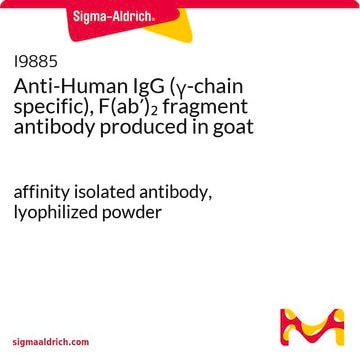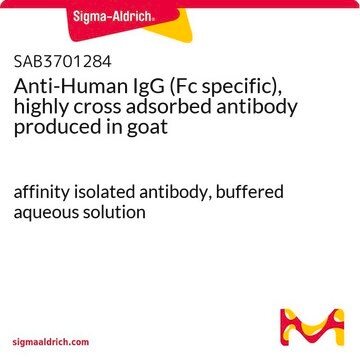I5260
Anti-Human IgG (Fab specific) antibody produced in goat
affinity isolated antibody, buffered aqueous solution
Synonym(s):
Fab-Specific Antibody
About This Item
Recommended Products
biological source
goat
conjugate
unconjugated
antibody form
affinity isolated antibody
antibody product type
secondary antibodies
clone
polyclonal
form
buffered aqueous solution
technique(s)
indirect ELISA: 1:50,000
quantitative precipitin assay: 2.0 mg/mL
shipped in
dry ice
storage temp.
−20°C
target post-translational modification
unmodified
Looking for similar products? Visit Product Comparison Guide
General description
Specificity
Immunogen
Application
- as starting material for conjugates using enzymes or fluorescent dyes
- in enzyme linked immunosorbent assay
- as a cross-linking antibody in internalisation of 125I-IgG by streptolysin-O-permeabilised cells
- as capture antibody in enzyme-linked immunosorbent assay (ELISA) for detection and semiquantitation of Fab
- in electrophoresis and immunoelectrophoresis
Biochem/physiol Actions
Physical form
Disclaimer
Not finding the right product?
Try our Product Selector Tool.
Storage Class Code
12 - Non Combustible Liquids
WGK
WGK 1
Flash Point(F)
Not applicable
Flash Point(C)
Not applicable
Certificates of Analysis (COA)
Search for Certificates of Analysis (COA) by entering the products Lot/Batch Number. Lot and Batch Numbers can be found on a product’s label following the words ‘Lot’ or ‘Batch’.
Already Own This Product?
Find documentation for the products that you have recently purchased in the Document Library.
Customers Also Viewed
Our team of scientists has experience in all areas of research including Life Science, Material Science, Chemical Synthesis, Chromatography, Analytical and many others.
Contact Technical Service









![Monoclonal Anti-Human IgG1 (Fab specific) [G1m(f)] antibody produced in mouse clone SG-16, ascites fluid](/deepweb/assets/sigmaaldrich/product/images/245/879/4f218cfe-aa20-409d-9449-056eba5e3d7b/640/4f218cfe-aa20-409d-9449-056eba5e3d7b.jpg)





